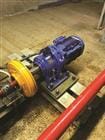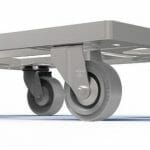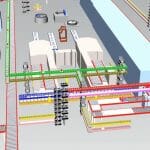Managing and maintaining vital travel infrastructure is a perennial problem. The only thing less tolerable to motorists than a traffic jam caused by maintenance work is an even longer traffic jam caused by equipment failure. When a busy drawbridge in Michigan failed at the start of a holiday weekend, local officials decided that a new motor drive system was needed. As part of this project, the backup drive system was installed with Warner Electric SFC Series clutch couplings to make sure traffic keeps moving even if the primary drive fails.
The River Grand is the longest river in the US state of Michigan and one of three major tributaries of Lake Michigan. This makes it a busy route for shipping, so any bridge lower than 60 feet above the water must open and close per U.S. Coast Guard requirements. The U.S. 31 bridge that spans the river at Grand Haven is one of the busiest in the state, with an average of 60,000 vehicles crossing daily – growing to 120,000 vehicles during busy weekends and holidays.
The double leaf bascule bridge was built in 1958 and has been a vital link in the local transport infrastructure ever since – coping with a continuous year-on-year growth in traffic. However, in recent years it has begun to experience malfunctions, culminating in the bridge becoming locked in the open position during the 2018 Memorial Day Weekend. This failure caused major traffic jams, so the Michigan Department of Transportation decided it was time to take action.
Some consideration was given to constructing a new, taller bridge to replace U.S. 31. However, preliminary investigations confirmed that the space a taller bridge would take up – once the approaches were built – would have a hugely negative impact on the local community and environment. Instead, a major refurbishment project was commissioned, with a new motor drive system taking priority.
As part of the project, the bridge’s backup drives were also upgraded. The new drive system is expected to operate for decades to come, meaning that some failures and maintenance issues will inevitably occur. The backup drive system is designed to quickly engage in the event of a failure to keep the bridge working while the main drive is being repaired. The new SFC Series of electric clutch couplings from Warner Electric, a brand of Altra Industrial Motion Corp., was installed to the backup drive shafts as a rugged solution that would maintain reliability even in adverse environmental conditions.
The stationary field clutch coupling (SFC) design doesn’t require brushes or collector rings to carry current, making them more robust and better suited to harsh environments or varying temperatures. They can be specified in both flange or bearing mounted styles and a splined hub and adapter serves as a coupling for in-line shaft applications.
Large size SFC-1525 bearing-mounted clutch couplings with 949 Nm static torque rating and a max. speed of 2,000 rpm were specified for the backup system (where required, a high-torque version of the SFC-1525 is available with 1,830 Nm rated torque). The in-line mounting ensured an economic and compact package, while the stationary field design means that the clutch will be unaffected by the varying weather conditions. It will be ready to operate at a moment’s notice whenever the backup drive system is needed. Designing and integrating drive systems for heavy-duty applications that see regular use is a challenging process – particularly where there is very little tolerance for downtime. Warner Electric offers expert advice during the design stages and can offer custom designs when needed. Operating as part of Altra Industrial Motion, it has a global presence, meaning it can provide local support for design, installation, maintenance and repair anywhere in the world.
For the U.S. 31 drawbridge, the refurbishment project improved the reliability of its operation while also speeding up its opening and closing times by several minutes. By Memorial Day 2019, the bridge was back to its usual reliable ways and the Michigan Department of Transport was able to reassure drivers that there would be no repeat of the prolonged delays experienced the year before.








